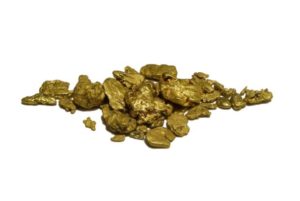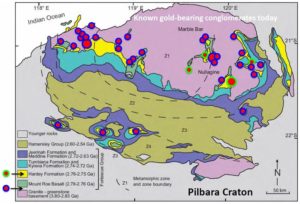The Secret of the Pilbara Gold Rush

By Alfred Stewart, B.Sc. Geology

Australia rarely makes the news in North America. Bill Bryson, the author of the amusing Aussie travel book In a Sunburned Country describes a search he did on the number of articles about Australia that appeared in The New York Times in a year. The total number of stories was only 20, which ranked Australia ahead of bananas in importance, but not as important a news item as ice cream. This is a shame because Australia is a fascinating country, where lots of interesting things happen, like the Pilbara Gold Rush.
It has been known for decades that a remote area of northwestern Australia has a similar, but not identical geological history to the richest gold field on Earth, the Witwatersrand Basin of South Africa, the “Wits”. There, over 1.6 billion ounces of gold have been mined since the late 1800s and 1 billion ounces of gold remain to be mined in current reserves. In the Pilbara, no mines currently exist like those in South Africa, but that may be about to change due to a ragtag group of prospectors, and a Canadian company, Novo Resources.
In 2016, near the town of Karratha, prospectors found an area of abundant gold nuggets about 8 km in length which attracted the attention of Dr. Quinton Hennigh. He is CEO of Novo Resources, and an expert on the geology of the Wits, who had been quietly working another area of the Pilbara at Beaton Creek, which had setting more akin to the Wits. Dr. Hennigh saw something which caused him to stake, buy, option or otherwise deal into over 10,000 square kilometers of the Pilbara. The question is, what did Dr. Hennigh see that caused him to have such an epiphany? What is the secret of the Pilbara Gold Rush?

The answer is in the shape, size, abundance and setting of the Pilbara gold nuggets at Karratha, led Dr. Hennigh to believe that the 8-km-long stretch of gold nugget-bearing ground was the Australian answer to the richest layer of gold in the Wits basin, the Central Rand ‘reef” as it is known. Hennigh believes that ancient Earth has oceans that were much richer in gold, and that life evolved the ability, about 2.8 billion years ago to concentrate gold in shallow marine areas off the ancient continent which encompassed both the Wits basin and the Pilbara Basin. He calls this a gold “event”.
In South Africa, much of the gold was gently eroded and redeposited in quartz pebble conglomerates, the richest being the Central Rand reef which contains abundant smallish grains of visible gold along with carbonaceous remains. In Australia, he saw coarse nuggets of gold in the shape of corn flakes and watermelon seeds. These look little like South African nuggets or nuggets found in modern placer deposits. Their characteristic flat shape is suggestive of a sedimentary layer of gold that was uplifted and perhaps baked above water level to form a concentrated layer of pure gold that was then violently ripped up and redeposited in a cannonball conglomerate. (See the photo of ‘watermelon seed’ gold)
Most of the carbon was removed, but some still exists on a microscopic level. The violent formation of the cannonball conglomerate had the potential to more energetically wash away smaller bits of rock and concentrate the gold mechanically to a greater degree than the Wits comparable. Also, sedimentary rocks are laid down in layers, like pages of a book. In South Africa, this book was tilted and the gold-bearing formations dip into the centre of the basin. Consequently, following the gold-rich reefs involved following the gold deeper and deeper underground as time went on. On the other hand, the Pilbara gold formations are like pages of a book lying flat on a table. Some of the area is exposed at surface, while most of it sits preserved under the cover of the book, a capping of basalt rock called the Mt Roe basalt. This geometry is better for mining. No wonder Dr. Hennigh got excited. He saw the potential for large rich gold deposits that are shallow, flat-lying and easily concentrated. That is the impetus for and the secret of the Pilbara Gold Rush.
Pilbara Region Exploration Companies
Novo Resources Corp. [NVO-TSXV]
NXGold Ltd. [NXN-TSXV]
Pacton Gold Inc. [PAC-TSXV]
Pilbara Minerals Ltd. [PLS-ASX]
Pioneer Resources Ltd. [PIO-ASX]
Platina Resources Ltd. [PGM-ASX]
Red Hill Iron Ltd. [RHI-ASX]
Rugby Mining Ltd. [RUG-TSXV]
Rumble Resources Ltd. [RTS-ASX]
Sayona Mining Ltd. [SYA-ASX]
Southern Hemisphere Mining Ltd. [SUH-ASX]
Strategic Elements Ltd. [SOR-ASX]
Tando Resources Ltd. [TNO-ASX]
Venturex Resources Ltd. [VXR-ASX]
Venus Metals Corp Ltd. [VMC-ASX]
West Wits Mining Ltd. [WWI-ASX]
Winmar Resources Ltd. [WFE-ASX]
Zenith Minerals Ltd. [ZNC-ASX]
Company list courtesy kaiserresearch.com
